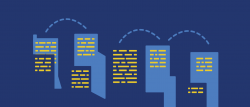Back to Basics: The History of IP Interface Addresses
In the previous blog post in this series, we figured out that you might not need link-layer addresses on point-to-point links. We also started exploring whether you need network-layer addresses on individual interfaces but didn’t get very far. We’ll fix that today and discover the secrets behind IP address-per-interface design.
In the early days of computer networking, there were three common addressing paradigms:
Back to Basics: The History of IP Interface Addresses
In the previous blog post in this series, we figured out that you might not need link-layer addresses on point-to-point links. We also started exploring whether you need network-layer addresses on individual interfaces but didn’t get very far. We’ll fix that today and discover the secrets behind IP address-per-interface design.
In the early days of computer networking, there were three common addressing paradigms:
The Why and How of a Two-Tier Network Monitoring Topology
A two-tier topology provides the freedom to upgrade the core network and various security and performance tools independently.What’s New in Calico v3.19
We’re excited to announce Calico v3.19.0! This release includes a number of cool new features as well as bug fixes. Thank you to each one of the contributors to this release! For detailed release notes, please go here. Here are some highlights from the release…
VPP Data Plane (tech-preview)
We’re very excited to announce that Calico v3.19 includes tech-preview support for FD.io’s Vector Packet Processing (VPP) data plane, joining Calico’s existing iptables, eBPF, and Windows dataplanes.
The VPP data plane promises high performance Kubernetes networking with support for network policy, encryption via WireGuard or IPSec, and MagLev service load balancing.
Interested? Try it out by following the tech-preview getting started guide!
Resource Management with kubectl (tech-preview)
In previous versions of Calico, the “calicoctl” command line tool was required to properly manage Calico API resources. In Calico v3.19, we’ve introduced a new tech-preview feature that allows you to manage all projectcalico.org API resources directly with kubectl using an optional API server add-on.
Try it out on your cluster by following the guide!
Windows Data Plane Support for containerd
Calico v3.19 introduces support for Calico for Windows users to deploy containers using containerd Continue reading
Passed AWS Associate Exam
I took the exam on 8th May 2021 and was able to crack it .Now you can call me AWS certified Associate .
I started thinking of giving the AWS associate exam more than a year back when my company provided us the free license of cloud Guru. We started a group of individuals who were interested in learning and taking the AWS associate exam. Our plan was to go through the cloud guru videos twice in a week during office hrs ( Allocated 1 hrs for learning ) and discuss any doubts related to topics. It all went very well for few weeks and suddenly people started missing sessions due to different reasons such as office meeting and workload. The group which started with 30 people reduced to 10 now and unfortunately I too dropped due to timing clash and office workload.
Almost after 6 months, again I started going through cloud Guru Videos and this time I was able to complete it and at that time i can easily rate myself 6 out of 10.
I went through AWS FAQ’s , I must say that they are must if you are preparing to take AWS exam.
I didn’t stop, Continue reading
Designing the new Cloudflare Web Application Firewall


The Cloudflare Web Application Firewall (WAF) protects websites and applications from malicious traffic attempting to exploit vulnerabilities in server software. It’s a critical piece of the broader security posture of your application. With that in mind, we made sure improvements to the Web Application Firewall dashboard experience made it easier to enable the WAF and configure rules to match the specific requirements of an application. In this post, I’ll share parts of the process we followed and the rationale behind the decisions we took when designing the new Web Application Firewall dashboard experience.
I’ve separated out my design process into three stages:
- Identify the tasks customers are trying to complete using the WAF
- Prioritise the tasks in such a way that it’s clear what the most common tasks are vs what the more involved tasks are
- Define, create, and refine the interface and interactions
Identifying the tasks customers are trying to complete
We support a range of customers — individual developers or hobbyists, small/medium-sized businesses where it’s common for a developer to fulfil multiple roles and responsibilities, through to large global enterprises where often there is an entire department dedicated to information security. Traditionally, product development teams use techniques such Continue reading
We Are the Internet Society: Our Impact in 2020

If there were doubts about how important the Internet is for everyone, 2020 put those to rest. As we push forward through this turbulent time, I want to take a moment to share some inspiration. The Internet Society’s 2020 Impact Report: The Internet Is a Lifeline is a storybook of ingenuity, collaboration, and what happens […]
The post We Are the Internet Society: Our Impact in 2020 appeared first on Internet Society.
NSA, ODNI and CISA Release 5G Analysis Paper
 Useful reading to understand network integrity, impacts and risk of mobile networks
Useful reading to understand network integrity, impacts and risk of mobile networks
BGP-Free MPLS Core with Segment Routing
After I created the Segment Routing lab to test the relationship between Node Segment ID (SID) and MPLS labels (and added support for IS-IS, SR-MPLS, and BGP to netsim-tools), I was just a minor step away from testing BGP-free core with SR-MPLS.
I added two nodes to my lab setup, this time using IOSv as those nodes need nothing more than EBGP support (and IOSv is tiny compared to IOS XE on CSR):
BGP-Free MPLS Core with Segment Routing
After I created the Segment Routing lab to test the relationship between Node Segment ID (SID) and MPLS labels, I was just a minor step away from testing BGP-free core with SR-MPLS.
I added two nodes to my lab setup, this time using IOSv as those nodes need nothing more than EBGP support (and IOSv is tiny compared to IOS XE on CSR):
Why Companies Are Migrating Legacy Systems to Cloud Infrastructure
Legacy-to-cloud migrations are happening for a wide range of reasons and are likely to only continue in earnest as businesses adjust to post-COVID location distributed work.Tech Bytes: Auto Dealer Takes Network Control With Fortinet (Sponsored)
Frustrated by poor service from an MSP, the IT team at White Family auto dealers needed a more efficient way to connect locations while ensuring high performance and strong security to meet regulatory requirements. The company chose Fortinet for its network and security equipment. Fortinet is our sponsor, and we talk with Shane Williams, Director of IT; and Paul Provorse, System Administrator about going all-in with Fortinet to run their own show.
The post Tech Bytes: Auto Dealer Takes Network Control With Fortinet (Sponsored) appeared first on Packet Pushers.
Tech Bytes: Auto Dealer Takes Network Control With Fortinet (Sponsored)
Frustrated by poor service from an MSP, the IT team at White Family auto dealers needed a more efficient way to connect locations while ensuring high performance and strong security to meet regulatory requirements. The company chose Fortinet for its network and security equipment. Fortinet is our sponsor, and we talk with Shane Williams, Director of IT; and Paul Provorse, System Administrator about going all-in with Fortinet to run their own show.How the Internet Really Works, Part 1

I’m a bit late posting this … but this Thursday (an odd day for me) I’m running How the Internet Really Works, Part 1, over at Safari Books Online. From the page:
You can register for the training at the link above. I’ll be giving part 2 of How the Internet Really Works next month.
Tracking Internet Shutdowns

Internet shutdowns harm societies, economies, and the global Internet infrastructure – that’s why we’re tracking disruptions on the Internet Society Pulse platform. There are thousands of disruptions to Internet access every day all over the world, but not all of them are the result of deliberate shutdowns. Lengthy outages are usually the result of technical errors, routing misconfigurations, or infrastructure failures. […]
The post Tracking Internet Shutdowns appeared first on Internet Society.